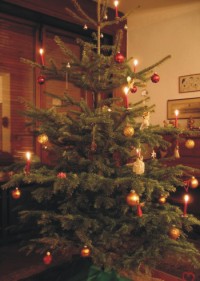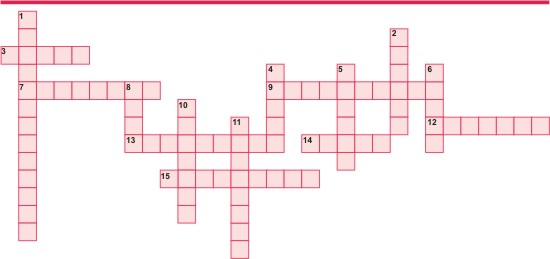|
Education


What
do you know about Christmas trees? Do you know how the tradition
began? In Britain many people will be buying Christmas trees
in the coming weeks, and in a month or so there will be a
lot of trees in people's dustbins. Read the article about
Christmas trees and then try to answer the questions.
 This
is a Christianization of the ancient pagan idea that the evergreen
tree represents a celebration of the renewal of life. In Roman
mosaics from Tunisia showing the mythical triumphant return
from India of the life-death-rebirth deity Dionysus, the god
carries a tapering coniferous tree. Medieval legends, nevertheless,
tended to concentrate more on the miraculous "flowering"
of trees at Christmas time. St Boniface, who converted the
German people to Christianity, was said to have come across
a group of pagans worshipping an oak tree. In anger, St Boniface
is said to have cut down the oak tree and to his amazement
a young fir tree sprung up from the roots of the oak tree.
St Boniface took this as a sign of the Christian faith. This
is a Christianization of the ancient pagan idea that the evergreen
tree represents a celebration of the renewal of life. In Roman
mosaics from Tunisia showing the mythical triumphant return
from India of the life-death-rebirth deity Dionysus, the god
carries a tapering coniferous tree. Medieval legends, nevertheless,
tended to concentrate more on the miraculous "flowering"
of trees at Christmas time. St Boniface, who converted the
German people to Christianity, was said to have come across
a group of pagans worshipping an oak tree. In anger, St Boniface
is said to have cut down the oak tree and to his amazement
a young fir tree sprung up from the roots of the oak tree.
St Boniface took this as a sign of the Christian faith.
 Among
early Germanic tribes the Yule tradition was celebrated by
sacrificing male animals, and slaves, by suspending them on
the branches of trees. In Scandinavia the Viking kings sacrificed
nine males of each species in sacred groves, while poorer
people hung apples and buns and other small sacrifices on
branches. It is likely that the Christmas tree is a continuation
of this tradition. Among
early Germanic tribes the Yule tradition was celebrated by
sacrificing male animals, and slaves, by suspending them on
the branches of trees. In Scandinavia the Viking kings sacrificed
nine males of each species in sacred groves, while poorer
people hung apples and buns and other small sacrifices on
branches. It is likely that the Christmas tree is a continuation
of this tradition.
The tradition
is most widely observed in the more northern parts of the
Northern Hemisphere (north of about 45°N latitude), at
the winter solstice when daylight hours are very short, and
temperatures often below freezing (0°C) with snow covering
the ground. In northern Europe such a promise of renewal was
essential at a time of death, darkness and cold.
Like many
other Christmas traditions, the universally-popular Christmas
tree is derived from a fusion of Christian ideas with older
pagan traditions. The custom originated in Germany. According
to one legend, Saint Boniface attempted to introduce the idea
of trinity to the pagan tribes using the cone-shaped evergreen
trees because of their triangular appearance. The tradition
of hanging decorations (representing fruit or gifts) on the
trees is very old, with some early reports coming from Germany's
upper Rhine region, but the tradition of attaching candles
is attributed to Martin Luther. A related tradition was hanging
evergreen branches throughout the home. With time, these evergreen
branches gave way to garlands, vines and wreaths.
Though
houses were dressed at Christmas with evergreen boughs, in
northern Europe, the Christmas tree was not customary in the
English-speaking world. In Britain, it was introduced by King
George III's German Queen Charlotte of Mecklenburg-Strelitz,
but did not spread much beyond the royal family until the
royal family Christmas centered round Prince Albert at Osborne
House was illustrated in English magazines, and copied in
the United States at Christmas 1850. Such patriotic prints
of the British royal family at Christmas celebrations helped
popularise the Christmas tree in Britain and among the anglophile
American upper class.
Answer
the following questions about the article.
1.
Who is depicted in the Roman mosaics?
2. What were the pagans St. Boniface found, worshipping?
3. How did early Germanic tribes celebrate Christmas?
4. Why is the Christmas tree tradition stronger in northern
parts of the Northern hemisphere?
5. According to one legend, why did St. Boniface choose the
fir tree?
6. Who is said to have begun the tradition of hanging candles
on trees?
7. Who introduced the Christmas tree to Britain?
8. Who popularised this tradition?
Can you guess the words for the crossword puzzle? Read the
clues and try to write in the words. Remember, one letter
per square.

Across
3. A group of trees that are close together.
7. The summer ........................... is the day of the
year with the most hours of daylight, and the winter ...........................
is the day of the year with the fewest hours of daylight.
9. If you describe a non-British person as ...........................,
you mean that they admire Britain and British culture.
12. In the Christian religion, the ...........................
or the Holy ........................... is the union of the
Father, the Son, and the Holy Spirit in one God.
13. A tree or bush which has green leaves all the year round.
14. A group of people with the same race, beliefs, customs
and/or language.
15. An adjective to describe someone who loves their country
and feels very loyal towards it.
Down
1. A fir tree, or an artificial tree that looks like a fir
tree, which people put in their houses at Christmas and decorate
with coloured lights and ornaments.
2. A ........................... of different qualities, ideas,
or things is something new that is created by joining them
together.
4. Beliefs and activities which do not belong to any of the
main religions of the world and take nature and a belief in
many gods as a basis. They are older, or are believed to be
older, than other religions.
5. A design which consists of small pieces of coloured glass,
pottery, or stone set in concrete or plaster.
6. A god or goddess.
8. A shape with a circular base and smooth curved sides ending
in a point at the top.
10. A circular decoration made from flowers and leaves. People
sometimes wear ..........................s of flowers on their
heads or around their necks.
11. Something that relates to or was made in the period of
European history between the end of the Roman Empire in 476
AD and about 1500 AD.
Answers:
1.
Dionysus, 2. An oak tree, 3. Sacrificing male animals &
slaves and suspending them from tree branches, 4. A promise
of renewal is needed at a time of cold, darkness and death,
5. Its triangular shape, 6. Martin Luther, 7. Queen Charlotte,
8. Prince Albert
Crossword:
1.
CHRISTMAS TREE, 2. FUSION, 3. GROVE, 4. PAGAN, 5. MOSAIC,
6. DEITY, 7. SOLSTICE, 8. CONE, 9. ANGLOPHILE, 10. GARLAND,
11. MEDIEVAL, 12. TRINITY, 13. EVERGREEN, 14. TRIBE, 15. PATRIOTIC
Copyright
(R) thedailystar.net 2004
|
